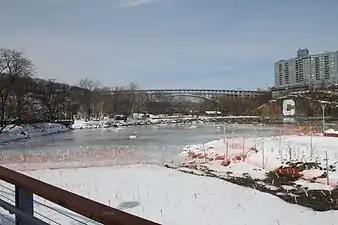| Muscota Marsh | |
|---|---|
 Muscota Marsh, with freshwater wetland covered by snow in foreground | |
| Type | Urban park |
| Location | Manhattan, New York City |
| Coordinates | 40°52′24″N 73°55′06″W / 40.873294°N 73.918376°W |
| Area | 1 acre (0.40 ha) |
| Operated by | New York City Department of Parks and Recreation |
| Status | Open all year |
Muscota Marsh is a one-acre public park in the Inwood section of the borough of Manhattan in New York City, on the shore of Spuyten Duyvil Creek, a section of the Harlem River. It is adjacent to the much larger Inwood Hill Park and Columbia University's Baker Athletics Complex. The park is notable for its views and for its ecological conservation features.[1]
"Muscota" comes from a Lenape word meaning "place of rushes"[2][3] or "place in the reeds".[4] Muscota Marsh is unusual for having both a freshwater marsh and a salt marsh in such a tiny area. Besides attracting plant and animal life, these wetlands are intended to help filter rainwater runoff and thereby improve the water quality of the river. Other facilities include a dock for kayaks and canoes, benches, and walking paths.[4] A wooden deck overlooking the river provides views of Inwood Hill Park, the Henry Hudson Bridge, and the New Jersey Palisades.[1]
Opened to the public in January 2014, the park was constructed by Columbia University as part of a deal to construct the new Campbell Sports Center within its adjacent athletics complex. It was designed by James Corner Field Operations, which also worked on Manhattan's High Line. It is cooperatively administered by the New York City Department of Parks and Recreation and Columbia, with the university providing maintenance and security.[4]
Gallery
 Salt marsh area, with small flags to discourage Canada geese from eating newly planted Spartina grasses.
Salt marsh area, with small flags to discourage Canada geese from eating newly planted Spartina grasses. View from park with Inwood Hill Park, Henry Hudson Bridge, N.J. Palisades, and Spuyten Duyvil section of the Bronx.
View from park with Inwood Hill Park, Henry Hudson Bridge, N.J. Palisades, and Spuyten Duyvil section of the Bronx. Boat dock and deck covered in snow, with Columbia "C" on opposite bank.
Boat dock and deck covered in snow, with Columbia "C" on opposite bank.
References
Notes
- 1 2 "Muscota Marsh". New York City Department of Parks and Recreation. Retrieved February 10, 2014.
- ↑ Grumet, Robert (1981). Native American place names in New York City. New York: Museum of the City of New York Produced by Pub. Center for Cultural Resources. p. 36. ISBN 978-0-89062-110-3. OCLC 7553276.
- ↑ Pirsson, J.W. (1889). The Dutch Grants, Harlem Patents and Tidal Creeks: The Law Applicable to Those Subjects Examined and Stated. L. K. Strouse. p. 1. Retrieved July 29, 2019.
- 1 2 3 Foderaro, Lisa W. (January 20, 2014). "With University's Help, New Park on Harlem River Is a Marshland Sanctuary". The New York Times. ISSN 0362-4331. Retrieved December 16, 2019.
External links
 Media related to Muscota Marsh at Wikimedia Commons
Media related to Muscota Marsh at Wikimedia Commons